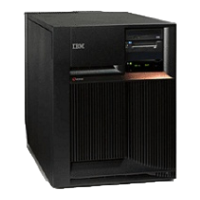c. Return to the procedure that sent you here.
This ends the procedure.
Resume
mirrored protection: For use by authorized service providers.
Use this procedure to resume mirrored protection on suspended disk units.
1. From the System Service Tools (SST) display or on the Use Dedicated Service Tools (DST) display,
select Work with disk units —> Work with disk unit recovery —> Resume mirrored protection.
2. On the Resume Mirrored Protection display, select the disk unit that you just replaced. It has a status
of suspended.
3. Is the disk unit in an Independent Auxiliary Storage Pool (IASP)?
v Yes: The disk unit that you selected will become active when the IASP is varied on.
This ends the procedure.
v No: Continue with the next step.
4. Are you in SST?
v Yes: The disk unit that you selected will become active when the system is operational.
This ends the procedure.
v No: Return to the Use Dedicated Service Tools (DST) display and perform an IPL. The disk unit that
you selected will become active during the IPL.
This ends the procedure.
Save
data and initialize disk unit: For use by authorized service providers.
To complete this procedure, you may need the latest set of Save System (SAVSYS) or SAVSTG tapes that
were made before the problem occurred. You will also need three blank tapes.
1. Are you exchanging a disk unit because a disk unit failure caused system operations to stop
completely?
v Yes: Continue with the next step.
v No: You may be able to use the Remove Units from Configuration function of DST. This function
allows you to move all data from the disk unit you want to exchange to the other disk units in the
same auxiliary storage pool (ASP). Go to step 17 (See page 550).
2. Perform an IPL to Dedicated Service Tools (DST). See Performing an IPL to DST in the iSeries
Service Functions
information.
Does the Use Dedicated Service Tools (DST) display appear?
v Yes: Continue with the next step.
v No: Did any messages regarding missing disk units appear?
– Yes: Ignore the messages and go to step 3 (See page 546).
– No: Repeat this step. If the same system reference code (SRC) occurs again, the customer
data is not recoverable. Go to step 5 (See page 547). If a different SRC occurs, use it to correct
the problem. (See System Reference Codes.)
This
ends the procedure.
3. From the Use Dedicated Service Tools (DST) display, perform the following to save the customer data
from the failing disk unit.
a. Select Work with disk units—>Work with disk unit recovery—>Save disk unit data.
b. On the Select Disk Unit Data to Save display, select the disk unit from which you want to save the
data. Record the ASP of the disk unit that you are saving. If the disk unit is missing, you cannot
save the customer data to tape at this time. Go to step 5 (See page 547).
546 Hardware (Remove and Replace; Part Locations and Listings)
